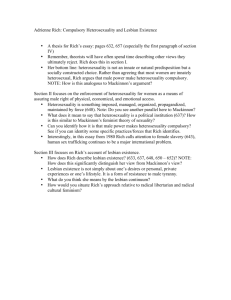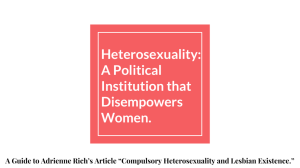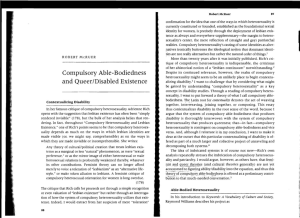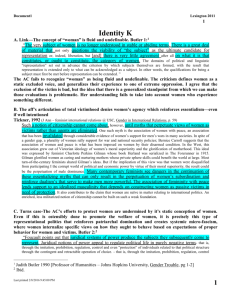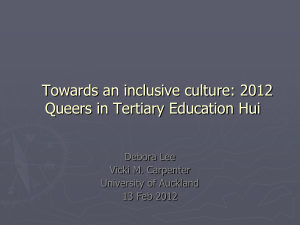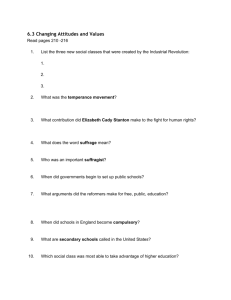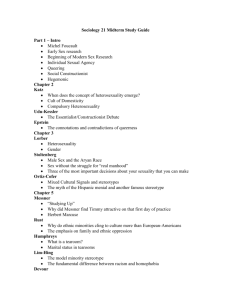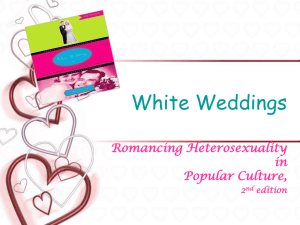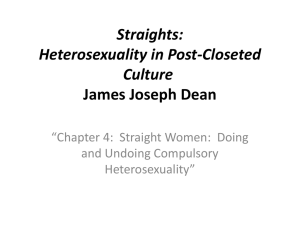Lecture # 12 Desiring Subjec..
advertisement
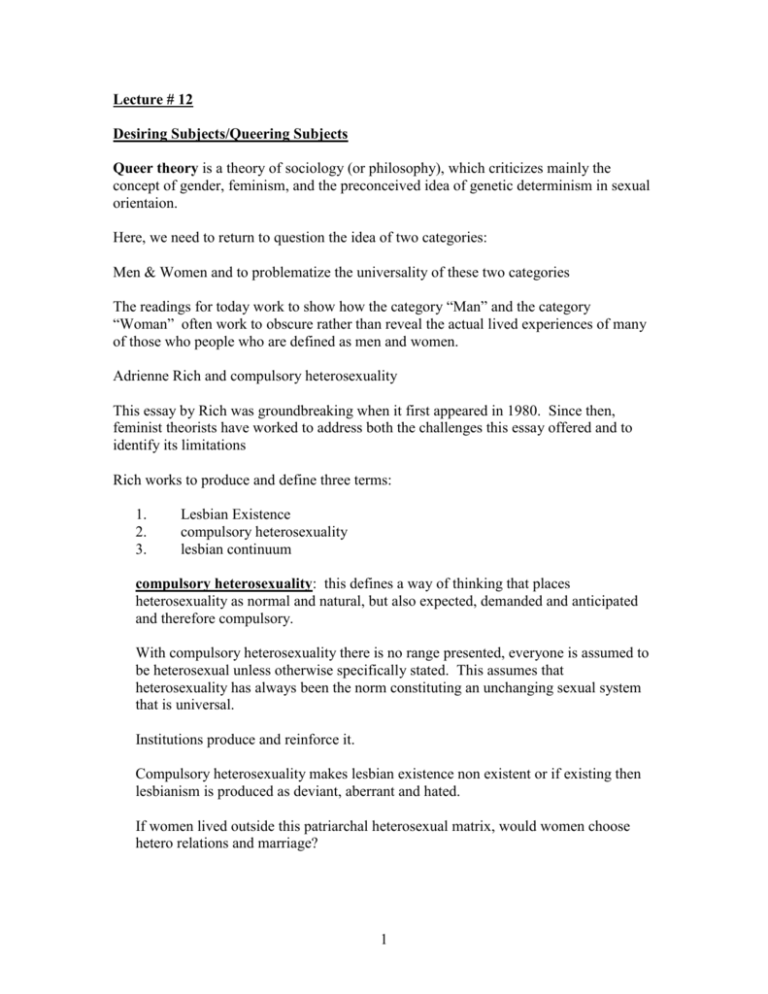
Lecture # 12 Desiring Subjects/Queering Subjects Queer theory is a theory of sociology (or philosophy), which criticizes mainly the concept of gender, feminism, and the preconceived idea of genetic determinism in sexual orientaion. Here, we need to return to question the idea of two categories: Men & Women and to problematize the universality of these two categories The readings for today work to show how the category “Man” and the category “Woman” often work to obscure rather than reveal the actual lived experiences of many of those who people who are defined as men and women. Adrienne Rich and compulsory heterosexuality This essay by Rich was groundbreaking when it first appeared in 1980. Since then, feminist theorists have worked to address both the challenges this essay offered and to identify its limitations Rich works to produce and define three terms: 1. 2. 3. Lesbian Existence compulsory heterosexuality lesbian continuum compulsory heterosexuality: this defines a way of thinking that places heterosexuality as normal and natural, but also expected, demanded and anticipated and therefore compulsory. With compulsory heterosexuality there is no range presented, everyone is assumed to be heterosexual unless otherwise specifically stated. This assumes that heterosexuality has always been the norm constituting an unchanging sexual system that is universal. Institutions produce and reinforce it. Compulsory heterosexuality makes lesbian existence non existent or if existing then lesbianism is produced as deviant, aberrant and hated. If women lived outside this patriarchal heterosexual matrix, would women choose hetero relations and marriage? 1 Lesbians exist and have always existed and this reality pushes against heteronormativity. For Rich, she defines the lesbian continuum as all aspects of women’s relations to one another without a necessarily sexual component [ for example: mothers, daughters, girlfriends, sisters, etc] There are 3 specific points of critique to consider with respect to Rich’s groundbreaking article 1. Rich uses the term patriarchy, but uses it in a way that presumes an essentialist, universal notion of patriarchy that is ahistorical. Which means that Rich does not problematize or historicize what she means by patriarchy. Patriarchy (from Greek: patria meaning father and arché meaning rule) is the anthropological term used to define the sociological condition where male members of a society tend to predominate in positions of power; with the more powerful the position, the more likely it is that a male will hold that position. 2. making patriarchy the main site of women’s oppression enacts its own form of harm and violence against women for whom gender and sexuality is not the dominant way that they experience their oppression. It is important that women have their own relations and imbalances of power. 3. Rich’s notion of a lesbian continuum is also ahistorical. By producing this category of a lesbian continuum to which she advances that all women belong, Rich renders invisible women’s desire and the specificity and particularity of lesbian existence. Having identified what is problematic in Rich’s argument, it is equally important to acknowledge that identifying and defining compulsory heterosexuality has helped to see what has for a long time has appeared as so natural and normal as to make all else invisible or deviant. The relation between Rich’s article and Kenneth Clatterbaugh’s article is to help us see, how those who are heterosexual, white, middle class, able bodied, Christian, etc. are often the model or presumed as the universal norm, while those who differ from any of these already complex categories are considered special interest groups, minorities, “special cases” which are named as such and either effaced or produced as outside the norm, which has complex effects on all of us and how we are able to experience and understand our world and our relations within it. Another aspect I would like you to consider is that “gay” is a term that is often equally applied to homosexual men and lesbian women, and yet using the term gay or 2 homosexual to refer to lesbian women also works to efface the gendered specificity of their experience. In the early days of the second wave of the women’s movement, the movement was dominated by the voices of white, heterosexual middle class women. The issue that became apparent was that other concerns such as racism, ablism, homophobia and ageism where considered add ons as other issues certain groups had to contend with, but as hopefully we have seen since the beginning of this course one’s complex identity and the issues one has to confront are not merely add ons but shape of very identities and our daily existence. The dominant form of masculinity is substantially shaped and maintained by homophobia, this fear is embedded in masculine gender roles, stereotypes and male ideals. Gay: implies a social identity and consciousness which is actively chosen Homosexual: refers to a specific form of sexuality. Homophobia: the intense fear and hatred of those in society considered or suspected of being homosexual. Homophobia as Clatterbaugh argues often works to shape emerging masculinities. From a young age a deep fear and hatred is instilled in boys against homosexuality. Often, the proof of one’s masculinity is through a deep, consistent and quotidian repudiation of homosexuality. By extension, boys grow up having to shape themselves as men by distancing themselves from anything that could remotely be associated with homosexuality and femininity, and doing so limits the potentiality of their humanity both toward themselves and toward others. Yet, it is equally true that neither heterosexuality nor homosexuality are universal categories some ways to being men and women conservative male stance: encourages homophobia and the protection of male privilege REAL women: conservative women’s groups who advocate traditional roles for men and women Father’s Rights Groups who pathologize the changes in women’s rights in the larger society Those (men and women) who oppose patriarchal ideology Those who advocate for separate realms for men and women, etc. 3 Clatterbaugh also discusses masculinity and racialization. Again being black and male is not a universal category, nor is racism narrowed to black/white binary Hypermasculinity when adopted by black men can be a defensive stance against racism and yet at the same time can work to further entrench racist stereotypes about black men. 4
